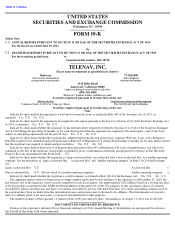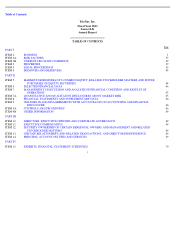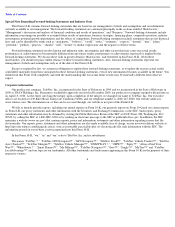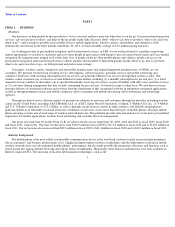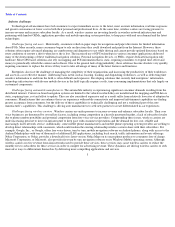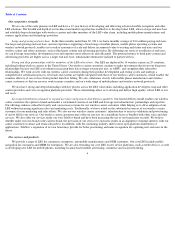TeleNav 2011 Annual Report Download - page 12
Download and view the complete annual report
Please find page 12 of the 2011 TeleNav annual report below. You can navigate through the pages in the report by either clicking on the pages listed below, or by using the keyword search tool below to find specific information within the annual report.
Table of Contents
Intuitive user interface . Our LBS provide one-button access to local information, an intuitive user interface and consistent features and
functions regardless of the mobile phone, mobile phone operating system or wireless network protocol the end user is utilizing. For many mobile
phones, we also offer customized user interfaces and features and functions based on the feature preferences of our wireless carrier customers,
including the ability to obtain directions from the end user’s contact data on the mobile phone without having to retype the address.
Easy feature and functions upgrades . We can automatically provide over the air updates of enhanced versions of our service to mobile
phones that use our recent client applications, without the need to upload new client software.
Cached data for operation with limited connectivity
. Our client applications are also built to address the realities of wireless networks. Our
client applications allow us to provide simplified navigation services even if users enter an area of no or limited network connectivity by caching
the route and navigation information along the route at the beginning of the trip.
Technology
Our proprietary technologies enable us to provide our LBS to millions of end users, across hundreds of mobile phones as well as all major
mobile phone operating systems and wireless network protocols. Our scalable LBS includes technologies that are deployed on the client and in
the back-end to deliver an integrated service. Our client technologies include a navigation and guidance engine and tools allowing us to
efficiently develop and deploy new applications to mobile phones. In addition, we have developed a cross platform framework and proprietary
markup language that allow us to extend our LBS applications across different mobile phone operating systems more efficiently, eliminating the
need for costly and time consuming redesign and development. In Europe and Canada, end users can select a language and our client software
interface and related services will be delivered in that language over the wireless network.
Our client application development processes, which include design, porting and publication processes, allow us to extend our services
effectively and efficiently to different mobile phones across multiple mobile phone operating systems, wireless network protocols, languages and
countries. Our processes also allow us to tailor our services to different mobile phone operating systems and address different feature preferences
of our wireless carrier customers. We work with our wireless carrier customers and mobile phone manufacturers prior to launch of new devices
to ensure our end users have an easy to discover intuitive product experience.
Our back-end technologies include our geographic information system, or GIS, engines for local search, mobile voice recognition, geo
alert and advanced geo data aggregation, traffic and a local advertising platform. We have developed customized voice recognition technology
built upon a third party voice recognition engine to serve the specific needs of navigation services and LBS customers. We are continuing to
leverage our existing back-end technologies for deployment to the automobile manufacturer and OEM solution opportunities. We are also
adapting existing technology in new ways to expand the connectivity and service offerings for in-car experiences, including interaction between
end users mobile devices and automobile hardware such as displays, sensors and audio systems.
We have developed a mobile search technology that focuses on information with localized relevance and accuracy to address the needs of
mobile phone users and the relatively small screens of mobile phones. We have developed a proprietary GIS which provides fast route and map
generation while optimizing the route based on current traffic conditions. Because our proprietary GIS uses less computing resources, these
efficiencies enable us to scale our servers more economically.
We have developed an application hosting and provisioning system that we integrate with the billing systems of our wireless carrier
customers. Our application hosting and provisioning system provides a range of billing options designed to maximize the attractiveness of our
services to end users with different payment
8


